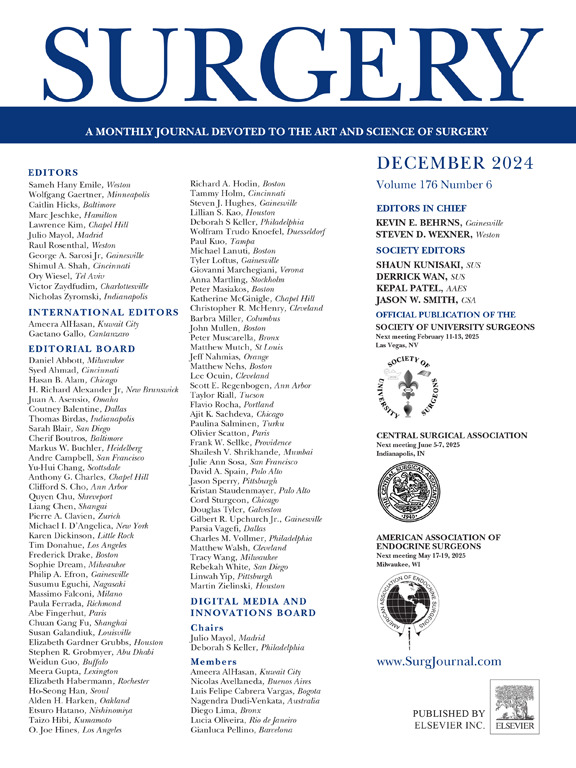Differences in grade C postpancreatectomy hemorrhage with or without clinically relevant pancreatic fistula after pancreaticoduodenectomy: A retrospective cohort study
IF 3.2
2区 医学
Q1 SURGERY
引用次数: 0
Abstract
Background
Pancreatic fistula is a major cause of late postpancreatectomy hemorrhage; however, it is not always accompanied by a postoperative pancreatic fistula, indicating other potential etiologies and characteristics. We investigated the role of clinically relevant postoperative pancreatic fistula in grade C postpancreatectomy hemorrhage and its potential as a classification criterion.
Methods
In this retrospective cohort study, we identified patients who developed grade C postpancreatectomy hemorrhage with or without concomitant clinically relevant postoperative pancreatic fistula after pancreaticoduodenectomy at the First Affiliated Hospital of Nanjing Medical University between January 2014 and December 2023. The patients' demographics, bleeding patterns, and outcomes were retrieved from their medical records and analyzed.
Results
Overall, 90 patients with grade C postpancreatectomy hemorrhage (52 [57.8%] with clinically relevant postoperative pancreatic fistula) were included in this study. Patients with clinically relevant postoperative pancreatic fistula had longer bleeding intervals (13.5 vs 7 days; P = .007). Although the gastroduodenal artery stump (32.7%) was the most common bleeding site in the fistula group, the hepatic artery and its branches (23.7%) and other bleeding points in the surgical area (23.7%) were predominant in the non-fistula group (P = .041). The fistula group had a greater mortality rate (38.5% vs 10.5%; P = .003), longer median length of hospital stay (42 vs 30 days; P = .047), longer intensive care unit stay (2 vs 0 days; P = .004), and greater hospitalization costs (RMB 283,632.73 vs RMB 189,087.6; P = .004).
Conclusion
The bleeding patterns and outcomes of grade C postpancreatectomy hemorrhage with and without concomitant clinically relevant postoperative pancreatic fistula varied. Therefore, postoperative pancreatic fistula could be considered as a new classification criterion for late postpancreatectomy hemorrhage.

胰十二指肠切除术后伴有或不伴有临床相关胰瘘的C级出血的差异:一项回顾性队列研究
胰瘘是胰腺切除术后晚期出血的主要原因;然而,它并不总是伴有术后胰瘘,这表明其他潜在的病因和特征。我们研究了临床相关的术后胰瘘在胰切除术后C级出血中的作用及其作为分类标准的潜力。方法回顾性队列研究选取南京医科大学第一附属医院2014年1月至2023年12月期间发生胰十二指肠切除术后C级出血伴或不伴临床相关胰瘘的患者。从患者的医疗记录中检索并分析患者的人口统计学、出血模式和结果。结果本研究共纳入90例胰腺切除术后C级出血患者,其中52例(57.8%)伴有临床相关的术后胰瘘。具有临床相关性的术后胰瘘患者出血间隔较长(13.5 vs 7天;p = .007)。虽然胃十二指肠动脉残端(32.7%)是瘘组最常见的出血部位,但非瘘组以肝动脉及其分支(23.7%)和手术区域其他出血点(23.7%)为主(P = 0.041)。瘘管组的死亡率更高(38.5% vs 10.5%;P = 0.003),中位住院时间更长(42天vs 30天;P = 0.047),重症监护病房住院时间较长(2天vs 0天;P = 0.004),住院费用更高(283,632.73元对189,087.6元;p = .004)。结论胰切除术后C级出血伴和不伴临床相关胰瘘的出血模式和结局不同。因此,术后胰瘘可作为胰腺切除术后晚期出血的新分类标准。
本文章由计算机程序翻译,如有差异,请以英文原文为准。
求助全文
约1分钟内获得全文
求助全文
来源期刊

Surgery
医学-外科
CiteScore
5.40
自引率
5.30%
发文量
687
审稿时长
64 days
期刊介绍:
For 66 years, Surgery has published practical, authoritative information about procedures, clinical advances, and major trends shaping general surgery. Each issue features original scientific contributions and clinical reports. Peer-reviewed articles cover topics in oncology, trauma, gastrointestinal, vascular, and transplantation surgery. The journal also publishes papers from the meetings of its sponsoring societies, the Society of University Surgeons, the Central Surgical Association, and the American Association of Endocrine Surgeons.
 求助内容:
求助内容: 应助结果提醒方式:
应助结果提醒方式:


